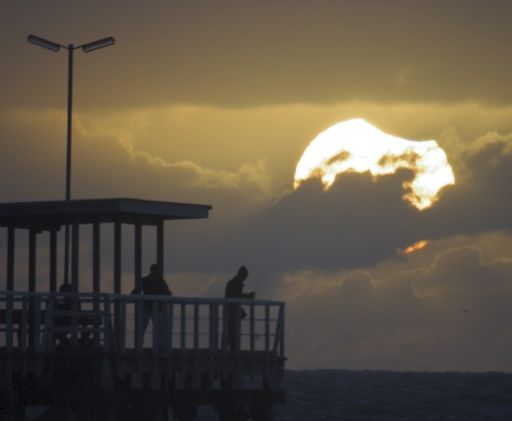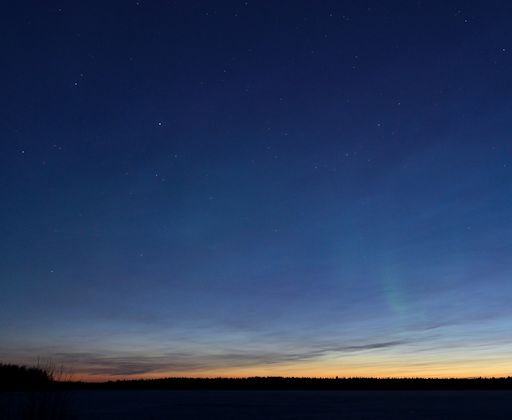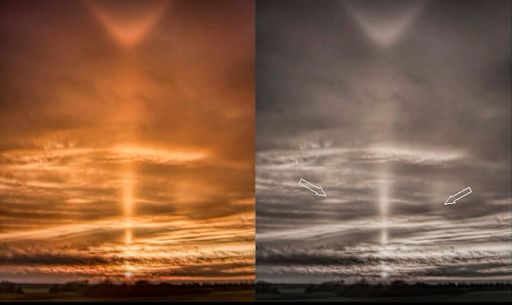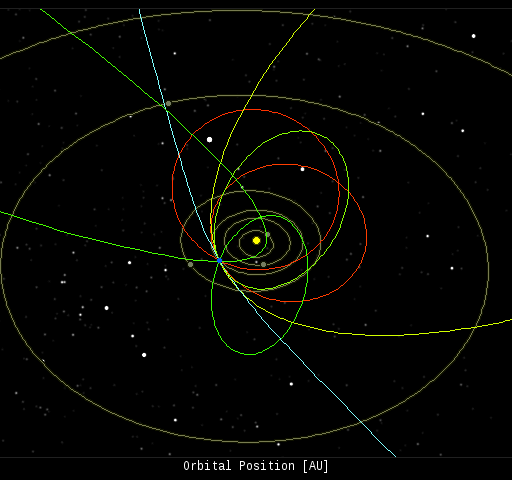Did you miss the lunar eclipse? No problem. The Coca-Cola Science Center recorded it for you. Click here to play the movie. | | |
MOTHER'S DAY AT THE EDGE OF SPACE: Mother's Day is right around the corner. Looking for a unique gift? How about an Edge of Space Mother's Day Card? This weekend, the students of Earth to Sky Calculus will launch a helium balloon to the stratosphere. For only $49.95, your Mother's Day, Father's Day, birthday or anniversary card could be on the payload. Profits from the flight are used to support the students' space weather balloon research program. Contact Dr. Tony Phillips for details.
AUSTRALIAN SOLAR ECLIPSE: Today when the sun set over Australia, sky watchers noticed something odd--a piece of the sun was missing. The new Moon passed in front of the sun producing a partial eclipse as deep as 70%. This was the view from Adelaide, South Australia:

"Here the eclipse peaked at 51% and was still in progress as the sun was setting," says photographer Martin Lewicki. "We could see it clearly through the clouds."
Visibility of this eclipse was restricted to Australia and the coast of Antarctica: map. While Australians witnessed a partial eclipse, in Antarctica the Moon passed directly in front of the sun, producing a "ring of fire" annular eclipse. Photographs of that phase, however, might not be forthcoming because of the remote location. Browse the eclipse gallery for updates:
Realtime Eclipse Photo Gallery
SOLAR SUPERSTORM NARROWLY MISSES EARTH: Two years ago, a Carrington-class solar storm narrowly missed Earth. If it had hit, researchers say, we could still be picking up the pieces. Get the full story from Science@NASA.
AURORAS vs TWILIGHT: Sky watchers around the Arctic Circle have a problem: too much daylight. As spring unfolds, twilight is spreading into the night, washing out all but the brightest auroras. Thomas Kast of Haukipudas, Finland, photographed the competition on April 25th:

"We aurora chasers, hunters and worshippers fight a battle against the magic midnight sun which cannot be won," says Kast. "Every night it gets brighter and the chances for auroras fade. As you can see from this photo - taken at 1.30am - the aurora is barely visible against the twilight. There are still a few nights with the sun more than 10 degrees below the horizon, but we will need a strong impact to see some nice auroras overhead."
The next impact might not be strong enough. NOAA forecasters expect a relatively weak stream of solar wind to brush past Earth's magnetic field on April 29th and 30th, sparking minor geomagnetic activity. Arctic sky watchers should be alert for auroras, but don't be surprised if all you see is twilight. Aurora alerts: text, voice
Realtime Aurora Photo Gallery
MYSTERIOUS SUN PILLAR ECHOS: Many of us have witnessed sun pillars--columns of light that lance upwards from the horizon just as the sun is rising or setting. They are caused by plate-shaped ice crystals in clouds that bend the rays of the low-hanging sun. While sun pillars are frequently seen, in all seasons and at all latitudes, elusive companions of sun pillars may have been frequently overlooked. They are called sun pillar "echos":

Image credit: Jon Inghram. Larger images: #1, #2
Atmospheric optics expert Les Cowley explains: "13 years ago in Finland, three halo experts saw peculiar 'echoes' straddling an otherwise ordinary sun pillar. They could not be explained and there the matter rested for want of confirmation by another observation. Then, last week, Jon Inghram sent me several sun pillar images. He too had noticed faint 'echoes' on each side of his pillar – the mysterious ice halo was at last confirmed!"
"More details and pictures may be found in an article here. But we still cannot explain them. The Finland observers, Jon and I have each tried simulations using the flattened pyramid crystals invoked to account for elliptical halos. They do not work at all well. We need many more observations! Take plenty of pictures of each pillar. The echoes are easily overlooked or mistaken for cloud patches and have probably been seen many times. Observations under different conditions could help unravel their mystery."
Realtime Space Weather Photo Gallery
Realtime Mars Photo Gallery
Realtime Comet Photo Gallery
Every night, a network of NASA all-sky cameras scans the skies above the United States for meteoritic fireballs. Automated software maintained by NASA's Meteoroid Environment Office calculates their orbits, velocity, penetration depth in Earth's atmosphere and many other characteristics. Daily results are presented here on Spaceweather.com.
On Apr. 27, 2014, the network reported 7 fireballs.
(7 sporadics)

In this diagram of the inner solar system, all of the fireball orbits intersect at a single point--Earth. The orbits are color-coded by velocity, from slow (red) to fast (blue). [Larger image] [movies]
Potentially Hazardous Asteroids (
PHAs) are space rocks larger than approximately 100m that can come closer to Earth than 0.05 AU. None of the known PHAs is on a collision course with our planet, although astronomers are finding
new ones all the time.
On April 29, 2014 there were potentially hazardous asteroids.
Notes: LD means "Lunar Distance." 1 LD = 384,401 km, the distance between Earth and the Moon. 1 LD also equals 0.00256 AU. MAG is the visual magnitude of the asteroid on the date of closest approach. | | The official U.S. government space weather bureau |
| | The first place to look for information about sundogs, pillars, rainbows and related phenomena. |
| | Researchers call it a "Hubble for the sun." SDO is the most advanced solar observatory ever. |
| | 3D views of the sun from NASA's Solar and Terrestrial Relations Observatory |
| | Realtime and archival images of the Sun from SOHO. |
| | from the NOAA Space Environment Center |
| | the underlying science of space weather |

